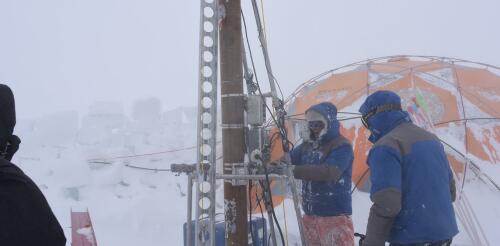Paleoclimatology
As humans alter the planet’s climate and ecosystems, scientists are looking to Earth’s history to help predict what may unfold from climate change. To this end, massive ice structures like glaciers serve as nature’s freezers, archiving detailed records of past climates and ecosystems – including viruses. We are a team of microbiologists and paleoclimatologists that studies ancient microorganisms, including viruses preserved within glacier ice. Along with our colleagues Lonnie Thompson, Virginia Rich and other researchers at the Ice Core Paleoclimatology group at The Ohio State University, we investigate interactions between viruses and their environment archived in ice cores from the Guliya Glacier on the Tibetan Plateau. By linking the genomes of ancient viral communities to specific climate conditions preserved in glacier ice, our newly published research offers insights into how these viruses have adapted to Earth’s shifting climate over the pas...
Over the past century, the Earth’s average temperature has swiftly increased by about 1 degree Celsius (1.8 degrees Fahrenheit). The evidence is hard to dispute. It comes from thermometers and other sensors around the world. But what about the thousands of years before the Industrial Revolution, before thermometers, and before humans warmed the climate by releasing heat-trapping carbon dioxide from fossil fuels? Back then, was Earth’s temperature warming or cooling? Even though scientists know more about the most recent 6,000 years than any other multimillennial interval, studies on this long-term global temperature trend have come to contrasting conclusions. To try to resolve the difference, we conducted a comprehensive, global-scale assessment of the existing evidence, including both natural archives, like tree rings and seafloor sediments, and climate models. Our results, published Feb. 15, 2023, suggest ways to improve climate forecasting to avoid missing some...
If you look back at the history of Atlantic hurricanes since the late 1800s, it might seem hurricane frequency is on the rise. The year 2020 had the most tropical cyclones in the Atlantic, with 31, and 2021 had the third-highest, after 2005. The past decade saw five of the six most destructive Atlantic hurricanes in modern history. Then a year like 2022 comes along, with no major hurricane landfalls until Fiona and Ian struck in late September. The Atlantic hurricane season, which ended on Nov. 30, had eight hurricanes and 14 named storms. It’s a reminder that small sample sizes can be misleading when assessing trends in hurricane behavior. There is so much natural variability in hurricane behavior year to year and even decade to decade that we need to look much further back in time for the real trends to come clear. Fortunately, hurricanes leave behind telltale evidence that goes back millennia. Two thousand years of this evidence indicates that the Atlantic has experie...


